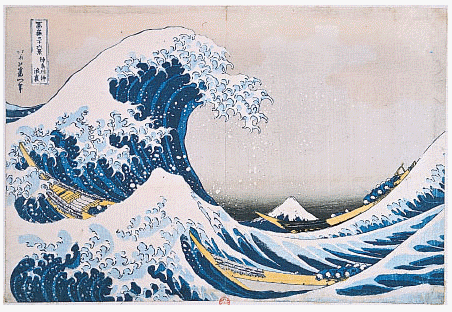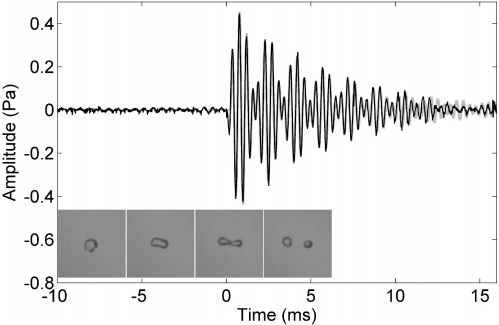Grant Deane – gdeane@ucsd.edu
Dale Stokes – dstokes@ucsd.edu
Marine Physical Laboratory
University of California, San Diego
Popular version of paper 1pAO1
Presented Monday afternoon, June 4, 2007
153rd ASA Meeting, Salt Lake City, UT
Breaking waves have been of interest to mankind since we first traveled on the sea. In addition to making life interesting for sailors, wave breaking limits the growth of waves when the wind blows, transfers energy from the wind to the sea, and helps to transport greenhouse gasses out of the atmosphere and into the ocean. Understanding the role of waves in ocean-atmosphere mixing is becoming increasingly important as rising levels of carbon dioxide lead to increased concern about global climate change.

The Great Wave, Hokusai (1760-1849)
When a wave breaks, it creates large numbers of bubbles, each one of which enhances the transport of gas across the ocean surface. This process is hard to model without measuring the bubbles, which is very difficult to do at sea during storms. An alternative is to study the bubbles and their formation by the noise they make, this being significantly easier to measure.
Each bubble, at the moment of its creation, produces a short pulse of sound. The musical quality of these tones is familiar: the babbling brook, the lively fountain and the roar of the waves all find their voice through bubbles. However, the connection between bubble formation and sound generation in breaking waves has been something of a mystery until recently. We now know that bubble fragmentation, the process of tearing a single bubble into smaller ones by fluid turbulence, is an important creation process inside whitecaps.
![]() The sounds of bubbles forming and fragmenting in ankle-deep water off the beach.
The sounds of bubbles forming and fragmenting in ankle-deep water off the beach.
Motivated by this new information, we made observations of bubbles fracturing in turbulent water to determine fundamental properties of their sound production, such as the level of sound and range of frequencies produced, and the dependence of these on bubble size. Figure 2 shows a typical result. The time plot shows the acoustic pulse from the two fragments of a fractured bubble (see the inset images). Sound emission begins shortly after fracture and each bubble radiates a pulse with a different frequency, depending on the bubble size. The superposition of the pulses results in the “beating” pattern of the pressure wave.

A time series plot of the sound radiated by the products of a fractured bubble. The vertical scale is acoustic pressure at 1 m. The inset images show the fragmenting bubble and bubble products at 1/250 s time increments. For scale, the diameter of the bubble in the left hand image is 3.4 mm.
The experiments have lead to some interesting conclusions. A wide range of frequencies, corresponding to a wide range of bubble sizes, can be produced by fragmentation, suggesting that bubble fracture is important for a broader range of bubble sizes in waves than previously thought. A broad range of sound levels were observed, showing that the excitation mechanism for sound production is sensitive to the details of bubble fragmentation. We observed that the sound level of fracture products was highly correlated, suggesting that the energy required to produce the sound comes from a common mechanism. Surface tension energy in the neck joining the bubbles immediately before fracture may be the source, but further observations are required to be sure.
The ultimate goal of this work is to support the creation of a remote sensing tool to measure bubble creation rates at the ocean surface using breaking wave noise, which will lead to improved models for air-sea gas transfer and a better understanding of the global carbon cycle. Studying the acoustics of fragmenting bubbles has lead to some insights about how this might be done.